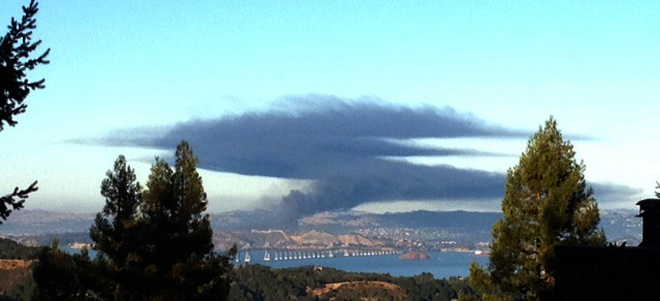Holding Chevron Accountable for the August 6th Refinery Fire

by CBE, taken from Mt. Tam
by Roger Lin, Staff Attorney
On August 6, 2012, the third and most catastrophic fire in five years at Chevron’s Richmond refinery injured six workers and created a toxic cloud that forced more than 15,000 people who live in the area to seek medical care.
CBE responded immediately by organizing neighborhood efforts to limit exposures to pollutants as the fire raged; backing community demands to correct official statements that downplayed the pollution’s impacts; holding community meetings to identify and address residents’ and workers’ needs; and helping provide a voice in the media for community expertise regarding the fire’s real impacts and causes.
Together with Richmond residents, workers and allies, CBE has developed a comprehensive agenda for health, justice and jobs:
- Build residents’ and workers’ capacity to achieve and sustain environmental and economic health through community organizing, participatory action research, and the public’s right to know about refinery pollution and solutions.
- Provide renewable and cleaner energy jobs for local residents and workers.
- Restore and protect environmental health and safety from refinery breakdowns, emergency releases, routine emissions, and greenhouse gas emissions in Richmond and the Bay Area.
By August 14th, CBE had won agreements by local officials to support timely disclosure of facts uncovered by the U.S. Chemical Safety Board’s (CSB) ongoing investigation of the fire. This right-to-know victory helped us get information we can use to prevent another such disaster. We learned that a corroded pipe Chevron could have replaced last year but did not-despite CBE’s warnings of more corrosive crude and workers’ warnings of growing corrosion problems-leaked for hours while Chevron kept running the plant. It then ruptured, spewing hot oil that ignited in the August 6th fire.
A key concern is that design flaws are among the suspected causes of the fire; rebuilding the old, damaged equipment before the CSB concludes its investigation may result in another, potentially more catastrophic, incident. On October 2nd the Richmond City Council unanimously passed a resolution, also endorsed by the Bay Area Air Quality Management District, to apply city permitting authority to require that Chevron use the safest, least-emitting technology in any repair of the damaged unit.
CBE’s effort to require that Chevron partially re-power the refinery with solar energy that would create local jobs instead of processing dirtier crude is also gaining ground. Re-powering with renewable energy will incrementally reduce emissions by requiring the refinery to burn less fossil fuel for its own electricity. On October 2nd, city leaders called on Chevron to work with CBE to create a Community Benefits Agreement that could commit resources to community-controlled development of solar jobs. And on October 4th, the Chemical Safety Board Chairman publicly agreed with our recommendation that the investigation of Chevron’s August 6th disaster should address corrosion caused by the refining of higher-sulfur crude.


